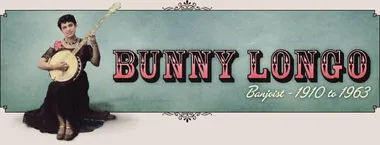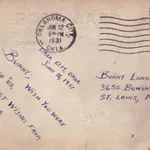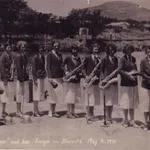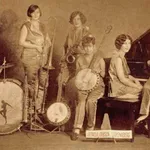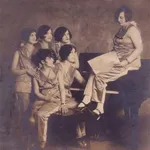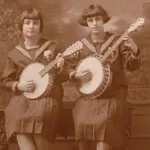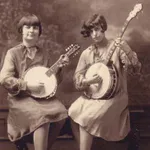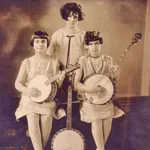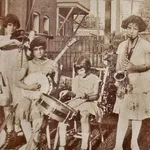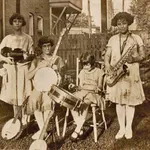Gallery: Longo Sisters and Georgia Gibson Serenaders
Photographs of Bunny with her three sisters (Margaret, Josephine, Nellie Mae) and Georgia Gibson Serenaders.
- Back of Postcard from Ginger and her Snaps
We can speculate from this message that Bunny may have performed with Ginger and Her Snaps in St. Louis and was asked to join them on this trip.
- Ginger and her Snaps – Enroute May 31, 1931
Bunny does not appear in this photo, but from the message appearing on the back (see next image) we can speculate that she may have performed with them in St. Louis and was asked to join them on this trip.
In September of 1930 her mother was quoted as saying: “She has had an offer to join the ‘Red Heads’, a girl’s orchestra, which has appeared several times at the St. Louis Theater, but this has been rejected, as Mr. Longo and myself feel that she is too young to go on the road.”
(Source: St. Louis Globe-Democrat Sunday Magazine, September 7, 1930) - Georgia Gibson Serenaders
“While she was a student at Roosevelt High School Bunny had an offer to play with the Gibson Orchestra, composed entirely of girls at Benish’s during the supper hour. She received pay for two hours work every night, and it was then that she decided to make music her livelihood.”
(Source: St. Louis Globe-Democrat Sunday Magazine, September 7, 1930) - Bunny & Sis
Bunny (right) and her sister Margaret (left) performed as a duet called “Bunny & Sis”.
- Bunny & Sis
Bunny (right) and her sister Margaret (left) performed together as “Bunny & Sis”.
“The mandolin made its appearance in our family circle after we had heard a girl play one at a Sunday school entertainment,” said Mrs. Longo. “Mr. Longo and I decided that one of our daughters should have a mandolin. Our next acquisition was a banjo to accompany the mandolin. I remember we met with quite a bit of family opposition at the time. One of Bunny’s uncles remonstrated (that the banjo was) ‘certainly nothing for a little girl.’ But Bunny was as captivated by the instrument as we were.”
(Source: St. Louis Globe-Democrat Sunday Magazine, September 7, 1930) - Longo Sister Trio
Later on Bunny and Margaret broadcast over a local station on the Buster Brown hour. Bunny played the banjo and Margaret the mandolin. They were widely known to the air audience as Bunny and Sis. Josephine played the saxophone and announced their programs.
(Source: St. Louis Globe-Democrat Sunday Magazine, September 7, 1930) - Four Longo Sisters
The Longo sisters made their debut as an orchestra about 1925, when their ages totaled less than half a century. That was before “Bunny” had become an avowed professional through affiliation with the union and there was nothing to hinder the family from appearing together. Their instruments in those days approximated their skill, which, although remarkable for so young a group of musicians, left much to be accomplished.
“Josephine’s saxophone,” said Mrs. Longo, “was a ‘tinny’ instrument, costing no more than $25. Last Christmas we gave her a $265 gold-plated saxophone. Margaret’s drums cost a good sum, too. You see, we give musical instruments instead of fur coats in this house for Christmas. ‘Bunny’ has about $500 invested in instruments which she purchased from her earnings.
“In the early days,” Mrs. Longo continued, “we used to play at lodge meetings for $1.50 an hour. And I couldn’t begin to count the dances, the church entertainments, the graduation exercises and parties at which we performed.”
(Source: St. Louis Globe-Democrat Sunday Magazine, September 7, 1930) - Four Longo Sisters
Margaret, Bunny, Nellie Mae, Josephine
The Longo sisters were raised in a musical atmosphere. As each one became old enough, she was given piano lessons. Always the finest of teachers were secured for her. And as she showed an inclination for a particular instrument, she was encouraged to study it.
(Source: St. Louis Globe-Democrat Sunday Magazine, September 7, 1930)
